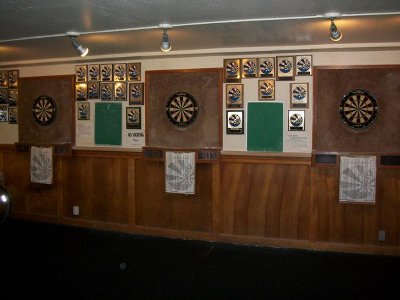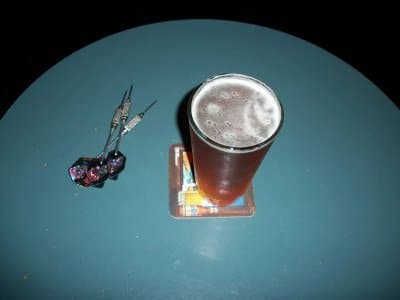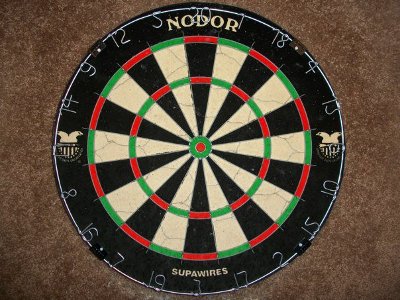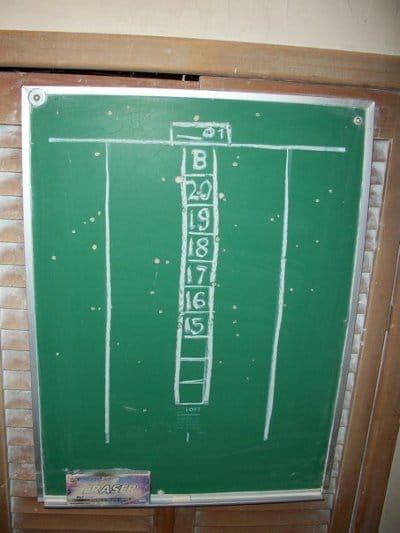Many of us have a favorite watering hole where we to go to unwind and have a good time. Some of us may prefer the dive bar, others the neighborhood brewery; some appreciate a younger crowd or the club/bar scene. I personally prefer the cozy pub, and in my town I’ve found one of the best I’ve come across. It’s an Irish pub that generally plays classic rock or doom metal music, it has an easy, neighborhood feel, and the best part? It’s unwavering dedication to one of the greatest pub games of all time: the game of darts. The pub boasts an entire room dedicated to the miniature arrows we so hazardously hurl at their Christmas-colored targets:

But this article is not about my cherished “Poet and the Patriot†pub. It’s about darts. Today we’ll talk about the different dart games that can be played and then next time we’ll provide a primer on dart throwing technique.

Darts and a frosty glass of beer: a winning combination.
Origins of the Game
According to the dart historian, Patrick Chaplin, the game of darts has its roots in archery. Other early origin possibilities include javelins and crossbow bolts, but seeing as how the early game of darts made use of an archery-like target, and the fact that the game is also widely known as “arrows,†it becomes rather clear that archery then, is its most likely ancestor.
I have to admit–I do not understand how this transition could have happened. Imagine some muscled, bow and arrow-wielding warrior saying to his compatriot: “Dude, imagine how much damage we could do if we made these things like an eighth the size, and then we threw them with our hands!?â€
Just doesn’t seem like a natural progression, does it? Maybe it was something thought up for the kids to do, who knows? At any rate, the game came to life in various disparate forms throughout England in the early 20th century. It was brought to the States towards the end of World War I by U.S. soldiers who played the game while in Europe and then brought the darts back home with them.
The world has never been the same. Happiness levels in bars throughout the world increased by leaps and bounds. Leagues were formed, events were planned, teams and friendships were forged. Despite a few traumatic pitfalls over the years regarding league recognition, the World Darts Council (now called the Professional Darts Corporation, or PDC) took the game to new levels. Currently, there is a world circuit with high profile competitions such as the Grand Prix, World Matchplay, the Las Vegas Desert Classic, and the World Championships.
Quick Note About the Dart Board

The dartboard is set up with three main areas: The single area, the double ring, and the triple ring. The ring on the outermost edge of the board is the double. If you hit a number in that ring, you get two marks, or, double points. The thin, inside ring is the triple. If you hit a number within that ring, you get three marks, or, triple points. The green bull’s-eye area is a single. The red is double. So, from outside to in, the dartboard is arranged as double ring, single area, triple ring, single area, green bull’s-eye, red bull’s-eye.
Types of Dart Games
Cricket: When you go to a pub and you see a chart on the wall next to the dartboard that is set up with the numbers 15 – 20 and the bull’s-eye, you know it is set up for cricket:

The point of the game is to “close†all of the numbers (15-20, you can ignore the rest of the board in this game) plus the bull’s-eye. That means you need to hit each number three times, or alternatively, hit a double and a single, or hit a triple.
To choose who goes first, both players throw a dart at the bull’s-eye; whoever is closest begins the game. If there is a tie, throw again. If you have closed a number before your opponent has closed the same number, and you hit that number again, then you receive that number of points. For example, say you have closed the 20. Your opponent, however, only has two marks on it and still needs one to close. If you hit a single 20 again, you get 20 points. The person to finish with all of the numbers closed and with the most points at finish wins. The green bull is 25 points and the red bull is 50.
301, 501, 801: The 01 series are popular dart games (501 in particular) and are all essentially the same, except that you begin with a different number of points depending on the number of people you are playing with. You begin with 301 points (or 501/801/etc.) and the objective of the game is to get to zero points the quickest.
You must hit a double to begin scoring (or rather, to begin subtracting points) and a double to win. Your goal is to hit the largest number per turn (19s and 20s) in order to win quickly. But here’s the thing: if you are shooting for an out, and you throw your exact score, you have to start over. Also, when shooting for an out, if you shoot a number higher than your current score, you go bust. Because of those two rules, the end can be tricky in a game of 301, 501, or 801 darts.
The variations: Depending on who you are playing with and the game, variations can include not having to “double in†or “double out.†Doubling out is almost always a requirement, but doubling in is optional. Generally, 801 is a team game played with four players or more but has the same basic organization.
Shanghai: To find out who goes first in a game of Shanghai, use the two-dart splash. That is, throw two darts at the same time. The order of turns goes from the highest score from the two-dart splash to the lowest. Shanghai is often played with four or more players.
The object of the game is to score the highest number of points by shooting at one number each round, for twenty rounds, thus making your way around the dart board. Begin by shooting at the number one in the first round, two in the second round, three in the third, etc… until you have covered the entire board. You only score points when you hit the number that correlates to the round you are on. The winner is the person with the most points at the end of the game, or, the person who hits a “Shanghai.†If you score a single, a double, and a triple of one number on its correlating round, you effectively “shanghai” the game and win immediately regardless of your opponents’ points.
Read Part 2: Technique, and impress your friends every time; maybe even win a few bucks!


